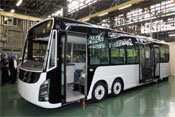Toshiki Nishiyama, Project Assistant Professor, Graduate School of Media and Governance
Research and development of an electric bus with a full flat floor

At the Electric Vehicle Laboratory of SFC, which is supervised by Professor Hiroshi Shimizu of the Faculty of Environment and Information Studies, we are carrying out research and development of a prototype of an electric bus with a full flat floor (approved by the Ministry of the Environment in 2009 as the “Project for Development of Diffusion Model of Advanced Ecological Technology under a Government-Industry-Academia Cooperation”). This is a project to promote eco-design, which is the most important feature of electric vehicles, and to realize a true universal design. Unlike conventional electric vehicles, the Electric Vehicle Laboratory has new technologies such as “in-wheel motors”, which is to place the motors inside the wheels separately, and a technology to mount lithium-ion batteries and inverter under the vehicle floor. All together, we call this “integrated platform”. By using the integrated platform technology, it is possible to use the vehicle interior above the floor spaciously and full flat.
If you think about conventional non-step buses, you would see that there are steps around the front-row seats placed on top of the tire house and the area behind the rear door. The full flat electric bus developed by Keio University, which has no steps that cause transfer resistance, makes easier and safer for aged and disabled people and makes user-friendly for everyone who uses it.
Another feature of development of this prototype vehicle is the cooperation among industry (Isuzu Motors Ltd.), government (Kanagawa Prefecture), and academia (Keio University). Isuzu Motors, which boasts a large share in manufacturing buses in Japan, has a facility in Fujisawa City. At the same time, Kanagawa Prefecture is a local government that aims to popularize electric vehicles on one of the largest scales in Japan, led by Governor Shigefumi Matsuzawa. Professionals in manufacturing buses, professionals in policymaking to spread electric vehicles and Keio University with its leading-edge technology on electric vehicles have collaborated to develop a large sized electric bus (10m in length/ 2.5m in width/ 2.8m in height). I also did a precise research on vehicle operation of 12 bus companies in Kanagawa, and estimated the capable mileage per charge (150km) for actual operation within the Prefecture, and the amount of battery necessary for that. Development of this bus also reflects efforts of research of bus companies and close communication with them. We focused on practicality, cooperating among industry, government and academia, intending commercial production in the future, and meeting the needs of those involved as much as possible.
Electric buses are emission-free and noise-free, therefore can go inside buildings and can run early in the morning or late at night to serve the needs of citizens, and can offer new services that were not possible previously. As a next step, we will conduct test drives on real bus routes, and will make further efforts to spread this technology home and abroad.
*This article appeared in the 2011 spring edition (No.270) of “Juku.”
*Position titles, etc., are those at the time of publishing.
